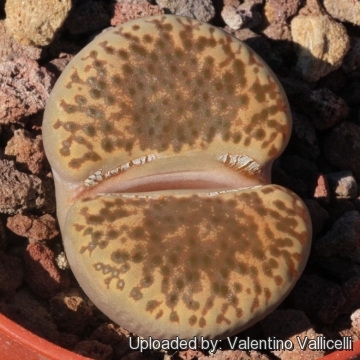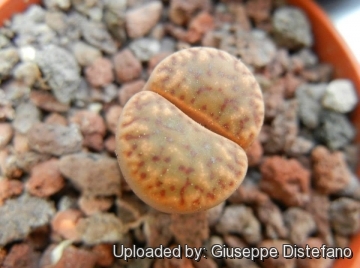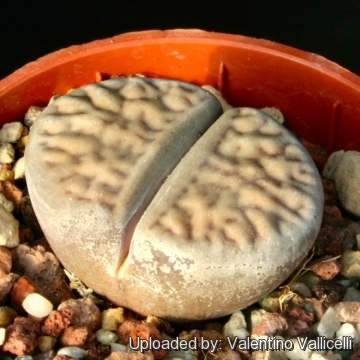
Lithops bromfieldii Photo by: Giuseppe Distefano
Origin and Habitat: South Africa, Northern cape (Districts Gordonia, Hay, and Prieska)
Habitat: Lithops bromfieldiiSN|12915]]SN|12915]] grows hidden under bushes or aloes on white greyish, brownish and red quartzite.
Synonyms:
See all synonyms of Lithops bromfieldii
back
Accepted name in llifle Database:Lithops bromfieldii L. BolusNotes Mesembryanthemum [H.M.L. Bolus] 2: 452. 1934 [23 May 1934]Synonymy: 26
- Lithops bromfieldii L. Bolus
- Lithops bromfieldii C040 TL: 15 km ENE of Upington, South Africa
- Lithops bromfieldii C041 15 km ENE of Upington, South Africa
- Lithops bromfieldii C279 45 km E of Upington, South Africa
- Lithops bromfieldii C348 20km East of Upington, Cape Province, South Africa
- Lithops bromfieldii C368 25 km SE of Upington, South Africa
- Lithops bromfieldii var. glaudinae (de Boer) D.T.Cole
- Lithops bromfieldii var. glaudinae C116 TL: 70 km WNW of Griquatown, South Africa
- Lithops bromfieldii var. glaudinae C382 70 km W of Griquatown, South Africa
- Lithops bromfieldii var. glaudinae C393 70 km NW of Griquatown, South Africa
- Lithops bromfieldii var. insularis (L. Bolus) B.Fearn
- Lithops bromfieldii var. insularis C042 15 km E of Keimoes, South Africa
- Lithops bromfieldii var. insularis C043 15 km E of Keimoes, South Africa
- Lithops bromfieldii var. insularis C057 10 km NE of Keimoes, South Africa
- Lithops bromfieldii var. menellii (L. Bolus) B.Fearn
- Lithops bromfieldii var. menellii C044 TL: 25 km SSW of Upington, South Africa
- Lithops bromfieldii var. menellii C283 20 km SSW of Upington, South Africa
- Lithops bromfieldii var. sulphurea C362 D.T.Cole
- Lithops rooi hort. ex Oesterr.
- Lithops rouxii hort. ex Oesterr.
- Lithops upingtonensis L. Bolus
Cultivars
(2):
back
Description: Lithops bromfieldii is a non-halophytic, medium sized Lithops, easily recognised by the bullate yellow-brown markings of the dark-green window, pinkish-grey facial colour and the many dark to blood-red rubrications. This species is quite variable and the colours and face pattern varies in plant from different provenance. As with many other Lithops species, several varieties have been described on the basis of variation in the colour of the tops of the leaves, the status of these uncertain, but all conforms to the typical Lithops morphology: two thick, fleshy windowed leaves separated by a crack from which a yellow flower appears. The windowed part allows light into the inner portion of the leaf where the process of photosynthesis is carried out.
Habit: Growths solitary or forming clumps of two to 10 or more heads, (mostly 2-4) to 1,5 cm high..
Bodies (paired leaves): Mostly about 25 X 20 mm obconical, truncate. The fissure is shallow, 4-8 mm; lobes conjunct, top surface flat or slightly convex and bullate generally reddish coloured. The face is elliptical to kidney-shaped more or less equal with window present ans irregular, very dark olive-green or more or less absent, and on this a number of bifurcated blood-red to dark brown-red lines, the forks ending in the sinuses of the outer margin, the surface is impressed by valley-like channels and raised islands, and bright to dark-blood red, orange-red rubrications sometimes scattered with dots, hooks and dashes in the channels.. Dusky dots dull dark greyish green. Outer margin lobed or laciniated, the lobes or laciniae projecting into the window and forming ridges or islands; islands and lobes bullate, coloured a brown-yellow; margin coloured light brown-yellow.
Flowers: Yellow, small to large 25-35(-45) mm in diameter.
Fruits: 5-chambered, profile boat-shaped, top flat.
Seeds: Yellow-brown, rugose.
Subspecies, varieties, forms and cultivars of plants belonging to the Lithops bromfieldii group
 Lithops bromfieldii L. Bolus: (var. bromfieldii) Medium sized with a bullate top surface and generally reddish coloured. Distribution: Cape province.
Lithops bromfieldii L. Bolus: (var. bromfieldii) Medium sized with a bullate top surface and generally reddish coloured. Distribution: Cape province. Lithops bromfieldii C040 TL: 15 km ENE of Upington, South Africa: rusty orange, red lines.
Lithops bromfieldii C040 TL: 15 km ENE of Upington, South Africa: rusty orange, red lines.- Lithops bromfieldii C041 15 km ENE of Upington, South Africa: dark red lines & dots.
 Lithops bromfieldii C279 45 km E of Upington, South Africa: like red-veined marble.
Lithops bromfieldii C279 45 km E of Upington, South Africa: like red-veined marble. Lithops bromfieldii C348 20km East of Upington, Cape Province, South Africa: variable, dark brown to milky green.
Lithops bromfieldii C348 20km East of Upington, Cape Province, South Africa: variable, dark brown to milky green. Lithops bromfieldii C368 25 km SE of Upington, South Africa: mostly rusty red
Lithops bromfieldii C368 25 km SE of Upington, South Africa: mostly rusty red- Lithops bromfieldii var. glaudinae (de Boer) D.T.Cole: Medium sized characterized by many dusky dots with a shining metallic reflex. Rubrications dull blood-red.
 Lithops bromfieldii var. glaudinae C116 TL: 70 km WNW of Griquatown, South Africa: graphitic luster.
Lithops bromfieldii var. glaudinae C116 TL: 70 km WNW of Griquatown, South Africa: graphitic luster. Lithops bromfieldii var. glaudinae C382 70 km W of Griquatown, South Africa: unusual form.
Lithops bromfieldii var. glaudinae C382 70 km W of Griquatown, South Africa: unusual form.- Lithops bromfieldii var. glaudinae C393 70 km NW of Griquatown, South Africa
- Lithops bromfieldii var. glaudinae cv. Rubroroseus
 Lithops bromfieldii var. insularis (L. Bolus) B.Fearn: This species is characterized by impressed valley-like channels, raised islands, and bold rubrications and is quite variable
Lithops bromfieldii var. insularis (L. Bolus) B.Fearn: This species is characterized by impressed valley-like channels, raised islands, and bold rubrications and is quite variable- Lithops bromfieldii var. insularis C042 15 km E of Keimoes, South Africa: dusky, with red dots.
 Lithops bromfieldii var. insularis C043 15 km E of Keimoes, South Africa
Lithops bromfieldii var. insularis C043 15 km E of Keimoes, South Africa Lithops bromfieldii var. insularis C057 10 km NE of Keimoes, South Africa: grey brown top, red lines.
Lithops bromfieldii var. insularis C057 10 km NE of Keimoes, South Africa: grey brown top, red lines. Lithops bromfieldii var. menellii (L. Bolus) B.Fearn: Medium sized form with rugose surface, pinkish-grey facial colour and very dark rubrications.
Lithops bromfieldii var. menellii (L. Bolus) B.Fearn: Medium sized form with rugose surface, pinkish-grey facial colour and very dark rubrications. Lithops bromfieldii var. menellii C044 TL: 25 km SSW of Upington, South Africa: grey brown top, red lines.
Lithops bromfieldii var. menellii C044 TL: 25 km SSW of Upington, South Africa: grey brown top, red lines. Lithops bromfieldii var. menellii C283 20 km SSW of Upington, South Africa: Hebrew script.
Lithops bromfieldii var. menellii C283 20 km SSW of Upington, South Africa: Hebrew script. Lithops bromfieldii var. mennellii cv. Pale Selection (MG 1561.8)
Lithops bromfieldii var. mennellii cv. Pale Selection (MG 1561.8) Lithops bromfieldii var. sulphurea C362 D.T.Cole: Small to medium sized green monster.
Lithops bromfieldii var. sulphurea C362 D.T.Cole: Small to medium sized green monster.
Notes: Lithops bromfieldiiSN|12915]]SN|12915]] is strictly related to Lithops bromfieldiiSN|12915]]SN|12915]] var. insularis, which grows in the immediate neighbourhood, but L. Bromfieldii differs from var. insularis in that there are no yellow-brown markings in the window. However L. insularis is not a variant form of L. Bromfieldii and it stands at the one end of the breadth of variation of L. Bromfieldii and that L. Bromfieldii, as described by L. Bolus, is at the other end. This can only be settled by an examination of these two species in their natural habitat.
Bibliography: Major refences and further lectures
1) Heidrun E. K. Hartmann “Aizoaceae F – Z” Springer 2002
2) Desmond T. Cole & Naureen A. Cole, Uwe Beyer, Yves Delange “Les Lithops” SUCCULENTES Spécial 2008 AIAPS (now Terra seca). I 2008
3) Desmond T. Cole & Naureen A. Cole “LITHOPS Flowering Stones” Cactus & Co. Libri. 2005
4) Yasuhiko Shimada“The Genus Lithops” Dobun Shoin. 2001
5) Rudolf Heine “Lithops - Lebende Steine” Neumann Verlag. 1986
6) Bernd Schlösser “Lithops – Lebende Steine” Praktische Anleitung für die Zimmerkultur. Bussiness Point MEDIA. 2000
7) Steven A. Hammer “Lithops – Treasures of the veld” British Cactus and Succulent Society. 1999
8) Gordon D. Rowley “The illustrated encyclopedia of succulents” Crown Publishers, 01/Aug/1978
9) David L. Sprechman “Lithops” Associated University Presses, Inc. 1970
10) Gert Cornelius Nel “Lithops: Plantae succulantae, rarissimae, in terra obscuratae, e famailia Aizoaceae, ex Africa australi” Hortors Limited, South Africa, 1946
11) Achim Hecktheuer “Mesembs, mehr als nur Lithops” Books on Demand GmbH Norderstedt. 2008
12) Werner Rauh “Die grossartige Welt der Sukkulenten” Hamburg and Berlin: Verlag Paul Parey, 1966
13) Stuart Max Walters “The European Garden Flora: Dicotyledons (Part I)” Cambridge University Press, 1989
 Locality: Welgevonden (Mesa garden 1557.6) Photo by: Valentino Vallicelli
Locality: Welgevonden (Mesa garden 1557.6) Photo by: Valentino Vallicelli Lithops bromfieldii Photo by: Giuseppe Distefano
Lithops bromfieldii Photo by: Giuseppe Distefano - Locality: Straussberg, Upington (dark orange-red lines - Mesa Garden 1550.56) Photo by: Valentino Vallicelli
- Locality: Straussberg, Upington (dark orange-red lines - Mesa Garden 1550.56) Photo by: Valentino VallicelliSend a photo of this plant.The gallery now contains thousands of pictures, however it is possible to do even more. We are, of course, seeking photos of species not yet shown in the gallery but not only that, we are also looking for better pictures than those already present.
Read More... Cultivation and Propagation: In the winter season the plant doesn’t need watering, the plant in this time extracts water from the outer succulent leaves, allowing them to shrivel away, relocating water to the rest of the plant and to the new leaves that form during this period. This plant is best for a well lit area (Bright shade to full sun). Water sparingly only when warm, no water when cold.













